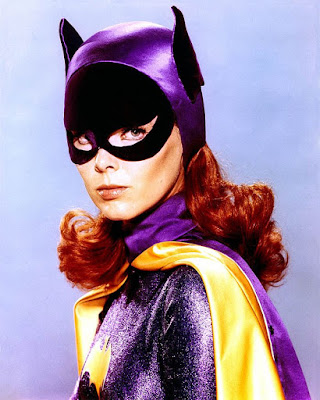About 15 years ago I went
to a Hollywood Collector Show, which was not held in Hollywood but
at the Beverly Garland Hotel in Burbank. Yvonne Craig was there and she was the
celebrity I was most excited to meet.
I believe our conversation went something
like this:
Me: Ummm…Hi
Her: Hi! Are you having
a good time at the show?
Me. Ummm…Hi
Her: Would you like me
to sign a photo for you?
Me: Ummm…Hi
And so on. But I did get a
signed photo that was proudly displayed for years on my office wall.
As every fan of good TV
knows by now, Yvonne Craig passed away last week. We have a no-obits rule
around here, but when Mitchell Hadley, one of the TV bloggers I most respect,
describes her passing as news that “no classic television blog worth its weight
could ignore,” I listen. So let’s call this a tribute as we did with the James Best piece.
Actually, a piece on Ms. Craig was roughed out several
months ago. She was going to be one in a series of blogs on Comfort TV stars
that were blessed with an exceptional magnetism that always drew your eye and
captivated your attention. With these actors it wasn’t about the role they
played, it was the charisma and personality they brought to it that made it
special.
It’s a quality that is hard
to define but you know it when you see it. James Garner and David Janssen had
it. So do Kate Jackson and Diana Rigg. Craig, like Jackson and Rigg, could
have coasted through a performance on her remarkable looks, especially when the
script didn’t call for much more than a pretty face. But she never did.
She appeared in memorable
guest spots on more than 50 different shows, from westerns (Bronco, Wagon Train, The Big Valley) to
sitcoms (McHale’s Navy, I’m
Dickens, He’s Fenster, The
Courtship of Eddie’s Father). I
can’t cover them all but here are some of the many highlights.
Yvonne Craig appeared in
five episodes of The Many Loves of Dobie Gillis (actually six including the pilot but that was just a walk-on). Dwayne Hickman as
Dobie played a dumb guy but in a smart way; he was very nimble with dialogue
and needed a strong female presence to play off of, which he always had in
regulars Tuesday Weld and Sheila Kuehl.
Playing five different
one-episode crushes, Craig always made a formidable match for the love-struck
Dobie. In “The Flying Millicans” she was Aphrodite, the toga-clad daughter of a
fitness-obsessed family; in “Dobie’s Navy Blues” she was Myrna Lomax whom Dobie
loved enough to almost join the Navy to please her father. Even in “Flow
Gently, Sweet Money,” working with a character clearly derivative of Tuesday Weld’s
money-hungry Thalia Menninger, she delivered delightfully cynical dialogue with
aplomb.
In the Star Trek episode “Whom Gods Destroy” she was Marta, the
green-tinted Orion slave girl. People remember her seductive dance but not the
dialogue around it, and that’s where Craig really created a haunting, (and
haunted) schizoid casualty that joins Khan and Harry Mudd among the series’
most memorable guest characters.
In The Wild, Wild West Craig played an assassin named Ecstasy (“The Night
of the Grand Emir”), who was so alluring that after her intended victim
survives he asks her out to dinner. As in Star Trek this was a role that made delightful use of her professional
dance training.
Craig also played a rich
girl turned beatnik in the appropriately named Mr. Lucky episode “Little Miss Wow,” the feisty daughter of a
missing sailor in Voyage to the Bottom of the Sea, and a meter maid on My Three Sons.
But it was her one-season
appearance as Batgirl opposite Adam West and Burt Ward that still overshadows a
lot of other fine work, a plight experienced by any actor fortunate enough to
create an iconic character.
The show really didn’t do
right by her much of the time. In the third and final season of Batman the
writing had slipped, most of the stories were no longer two-parters with
cliffhangers, and poor Batgirl was usually captured far too quickly by chumps
like Lord Fogg and Louis the Lilac.
And yet, every episode in
which she appeared was a joy. Craig’s Batgirl was a carefree superhero, the
antithesis of the dark and brooding caped crusaders of more recent films. She
smiled and high-kicked through every fight, and radiated confidence each time
she bounced into a room, head tilted back, hands on hips, ready for action.
I bought the Batman series blu-rays about three months ago and have
been getting reacquainted with the show ever since. The third-season is coming up soon and I expect the experience of watching it will be
bittersweet. But I will still be happy to see Batgirl again.













